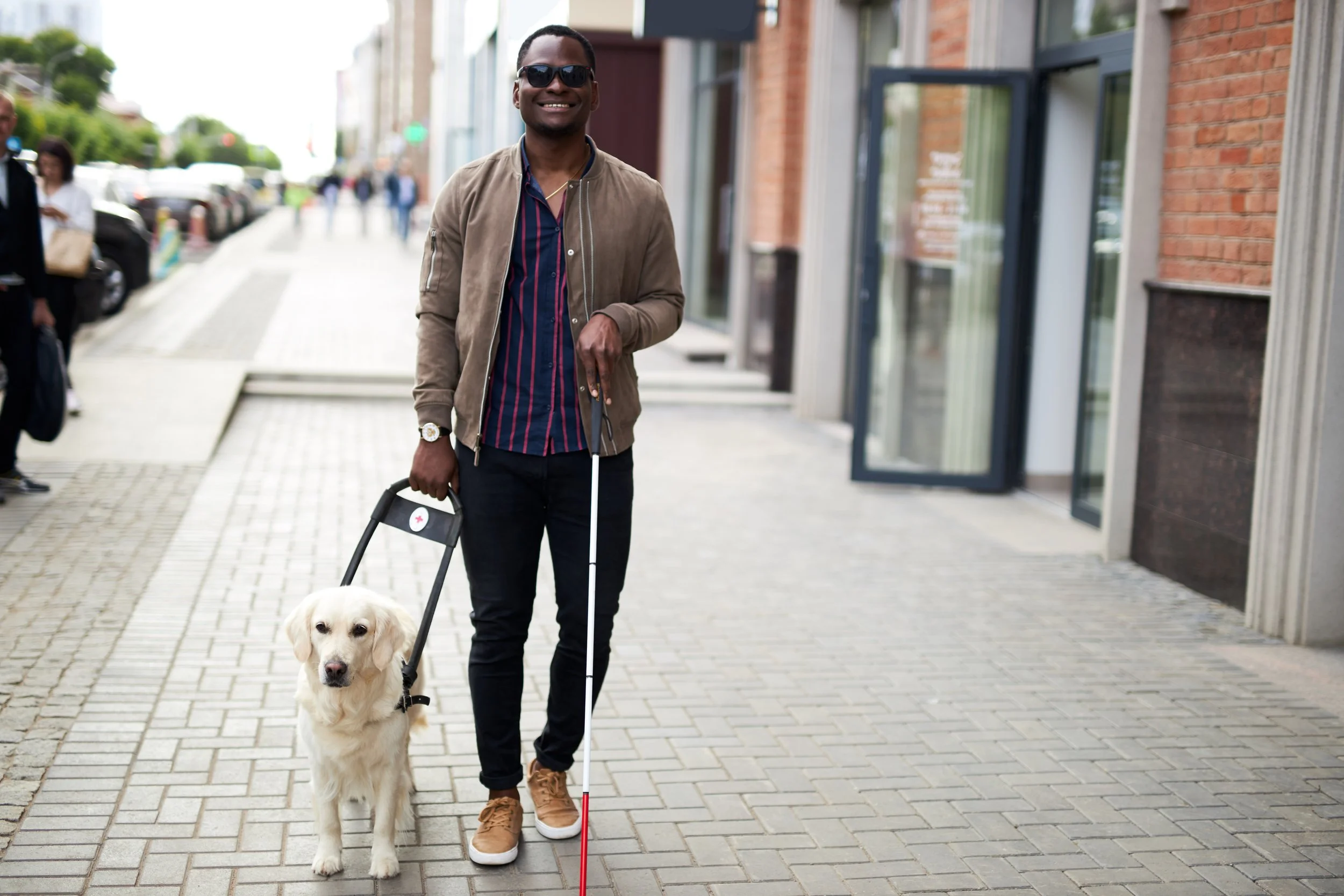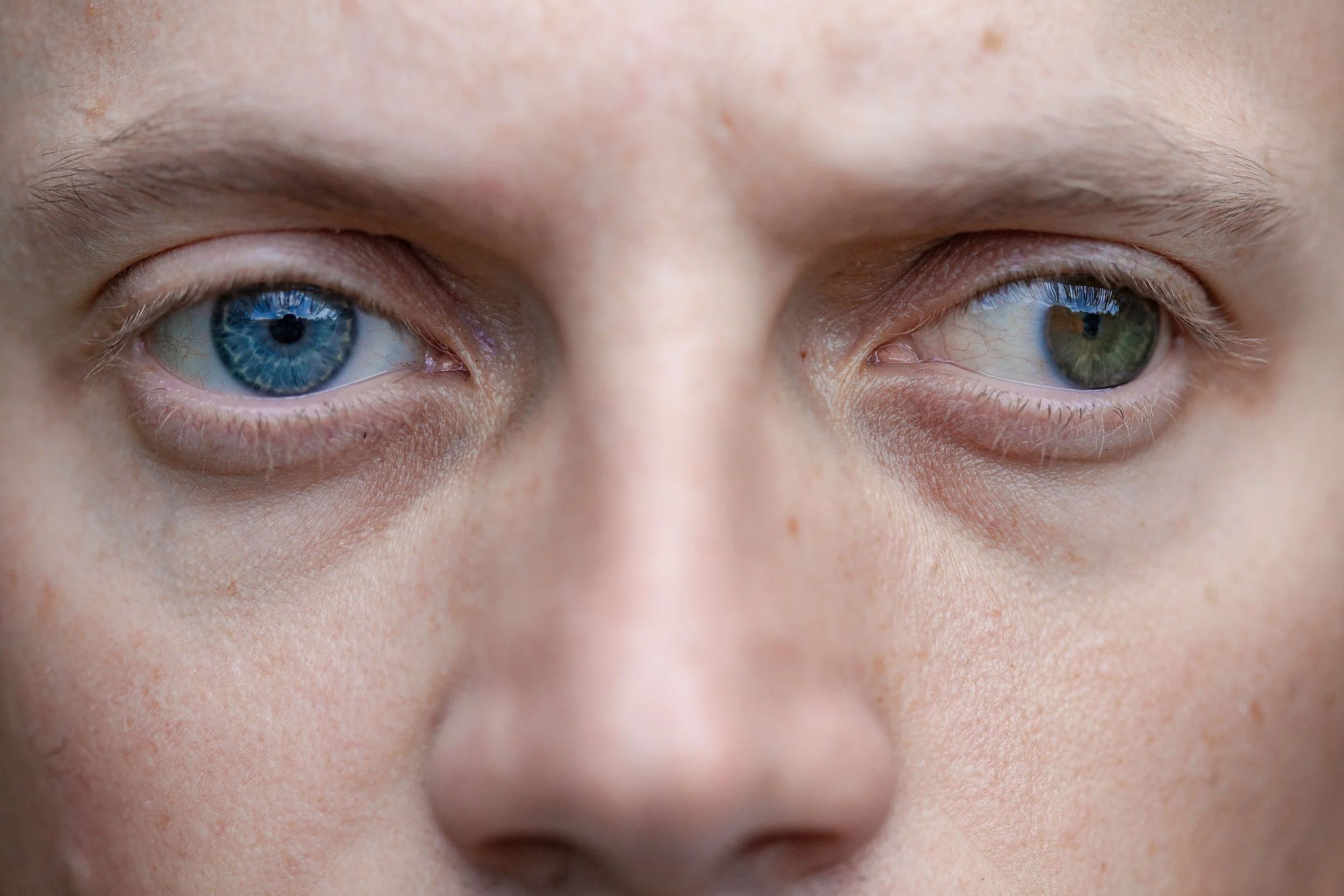Beyond Vision: Thriving in Life After the Loss of Sight
Image: A blind man walks outside with his guide dog and white cane.
Last week, we explored the realities of dual sensory loss, which is the combined experience of losing both hearing and vision, and how it affects independence, emotional health, and one’s connection to the world. This week, we turn our focus to one of those senses in particular: vision loss.
Blindness and vision loss, whether partial or total, bring profound changes to a person’s daily life, both physically and emotionally. Adjusting to life after losing sight not only requires learning new skills, but also reckoning with and accepting that one of the primary ways we experience the world has changed, for good. But with the right skills training, assistive tools and technology, support, and community, independent living and a fulfilling life are available.. For those experiencing vision loss, CPWD’s Beyond Vision program offers both skills training and personal support as a path to acceptance and independence.
What is Visual Impairment?
In the U.S., more than 12 million people aged 40 and older live with some form of visual impairment. One million are fully blind, and that number rises significantly after age 65.
Image: A close-up of a person with a visual impairment.
Visual impairment is more complex than most people realize. It exists on a spectrum from mild to moderate visual impairment, to significant visual impairment, to total visual impairment, or blindness. A person may be considered legally blind if their vision is 20/200 or worse in their better eye, even with glasses, or if their visual field is 20 degrees or less (this means they can only see straight ahead without moving their eyes, and that their peripheral vision is significantly diminished). The broader definition of significant visual impairment is vision that cannot be fully corrected by glasses or contact lenses and significantly affects an individual’s ability to perform daily tasks.
Significant visual impairment is a disability, as it interferes with our ability to fully function and live independently. And the incidence of vision loss increases with age. 18% of the 65-and-older population in the U.S. experience vision loss; that ratio grows to 25% for the 80-and-older group. Due to attitudes rooted in discrimination (which we continuously work to change in favor of inclusivity and diversity), some older adults are reluctant to acknowledge that they have a disability. Rather, they consider vision loss just “getting old.” The challenge is that vision loss can place a huge burden on aging adults, and without skills training and support, lead to other challenges such as injury, isolation, loneliness, depression, waning mental and physical health, and even premature transition to a nursing home. Older couples face a challenge when one loses their vision and the other tries to become the de facto caretaker. This scenario typically quickly results in loss of independence, stress and worry, and reduced quality of life and living.
The good news is, vision loss at any age does not mean the end of independence. With skills training, assistive technology, education, understanding about the causes and treatments, and peer support, most people of any age can continue to live independent and full lives.
A Program That Meets People Where They Are
Image: Best Gustin stands in front of a group of people with her guide dog, speaking into a microphone, during a Beyond Vision training.
Beyond Vision was created with a simple goal: to ensure that people experiencing blindness or vision loss can continue living the lives they choose, on their own terms.
The program provides individual and group support for people who are blind or visually impaired. Beyond Vision includes a continuum of education and information, skills training, assistive technology training, and peer support that, together, create a foundation for adapting to vision loss, living independently, and cultivating social support and friendships. Some of the services are:
Orientation and mobility training (white cane training)
Daily living skills
Navigating home spaces
Personal organization using bump dots, penfriend, and other assistive technologies
Personal health and hygiene
Cooking safely and eating healthy - preparing fresh foods is challenging without new skills related to shopping, food preparation, using knives, stove use, cooking, and clean-up.
Assistive technology
Learning to use magnifiers, screen readers, iPhone and Android voice-over utilities, and more.
Learning to use email, phone, and other modes to communicate with doctors, family, and friends.
Accessing transportation and community spaces
Learning to use public transportation, accessible ride services, and other modes of transportation safely
Learning to navigate sidewalks, streets, parks, stores, and other public spaces safely.
Peer Support
Beyond Vision offers several Peer Support groups every week, in-person, online, and hybrid.
Peer Support groups provide education about vision loss by staff and guest speakers, updates on the latest medical findings and available assistive technology.
At groups, participants share their experiences, challenges, and successes, learning from each other, fostering hope and confidence, and building friendships and community.
Peer leadership emerges naturally as those who overcome their own barriers and obstacles to independent living naturally encourage and support others, often leading groups and creating offshoot social and skills-building cohorts.
Periodic fun and social gatherings and outings such as narrated movies and ballet performances, as well as game nights, art days, and more give participants a way to enjoy life and fellowship.
To find out about our current Peer Support groups for Beyond Vision, visit our Services Calendar.
All of CPWD’s Beyond Vision services are offered at no cost to the consumer. The program is funded by a combination of grants and other fundraising.
A Success Story
In our previous article, Peer Support: The Heart of Independent Living, we shared the story of a woman who came to her first support group at CPWD’s Thornton office during the winter, carrying the weight of seasonal depression, family stress, and the emotional toll of living with a disability. At the urging of her Beyond Vision SkillsTrainer, she showed up, nervous at first, and listened quietly.
At that group, something shifted for her. As others shared openly, she found the courage to speak. That first experience of being seen, of not needing to explain herself, sparked a renewed sense of hope. She came to the next group. She made a close friend. The two of them started a book club. Her confidence grew. She attended a training at the Colorado Center for the Blind. She joined CPWD’s “Walk, Talk & Roll” group, taking to the sidewalks with her white cane in hand and a new energy for life. Today, she is championing living independently with visual impairment through her participation, peer leadership, book club, and other activities.
Her story is one of many. She reminds us that transformation doesn’t always begin with a bold decision. It can start with a quiet presence in a room full of strangers who become allies. Often, just showing up is the hardest part, and then the feeling of loss and loneliness gives way to fellowship and hope.
Hands-On Learning and Demos: The Assistive Tech Library
Image: Blue metal cabinets full of assistive technology are lined up against a wall in CPWD’s Assistive Technology Library.
Vision loss often demands the use of specialized tools, but those tools can be expensive, and not every device works for every person.
We are fortunate today that sophisticated technology is available to assist individuals with vision loss. Not even 50 years ago, the best we had was a cane, a helper, and perhaps Braille if you were affluent enough to learn and have access to books. In 2025, just an iPhone can do more to open access to information and communication than all the tech in the last century. Magnifiers, screen readers, talking devices, textured labeling systems, and more make living independently with vision loss possible for most.
Thanks to a 2023 grant from the James Hynd Trust, CPWD built an Assistive Technology Library and Training Center. Here, participants can come to try and train on more than 100 different kinds of assistive technology. Further, they can find the tech that works best for them before purchasing. Previously, people with visual impairment would rely on descriptions of tech and its function, had to buy without trying, often discovering that what they just bought doesn’t meet their needs. This increased costs and time-to-access. With the Tech Library, they can train on the tech they want, purchase the ones that meet their needs, and accelerate their skills training and independence.
The Assistive Tech Library is not only for consumers, but also open to other nonprofits and organizations, as well as community members and families, by appointment. To find out more, please email Alexia Diaz, Beyond Vision Manager.
Accessible Support Across Colorado
Beyond CPWD, Colorado is home to several organizations dedicated to supporting individuals who are blind or have visual impairment. Each offers valuable resources tailored to different needs and stages of the vision loss journey:
Colorado Center for the Blind (Littleton): Offers intensive skills training, community living programs, and confidence-building services for people of all ages.
Ensight Skills Center (Fort Collins and statewide): Provides low vision assessments, occupational therapy, support groups, and adaptive technology training.
Division of Vocational Rehabilitation – Blind and Low Vision Services: Offers employment readiness, home independence training, and mobility skills through state-supported services.
National Federation of the Blind of Colorado: Connects individuals to advocacy networks, peer groups, and leadership opportunities rooted in lived experience.
These organizations play an important role in Colorado’s broader landscape of support. However, some services may involve out-of-pocket costs, waitlists, or eligibility requirements.
CPWD recognizes that financial barriers can be an obstacle to accessing services.. That’s why all services through Beyond Vision are offered at no cost to the consumer. Whether someone is adjusting to a new diagnosis, building independent living skills, exploring assistive technology, or finding connection through peer support, these resources are available and accessible to all.
You (or your loved one) is Not Alone
Every week, people across Colorado connect with Beyond Vision and take their next step toward a fulfilling, independent life. Some are learning to use a white cane for the first time. Others are rediscovering technology, relearning how to cook, or simply gathering with peers for coffee and conversation.
Each story is different. But together, they form a powerful truth: vision loss is not an end to living a fulfilling and independent life. With some simple skills training and support, people can move forward, thrive, and live a life full of connection, purpose, and joy. Beyond Vision is here to help people find it.
To learn more about how Beyond Vision can support you or your loved one, email us at info@cpwd.org or call (303) 442-8662.





